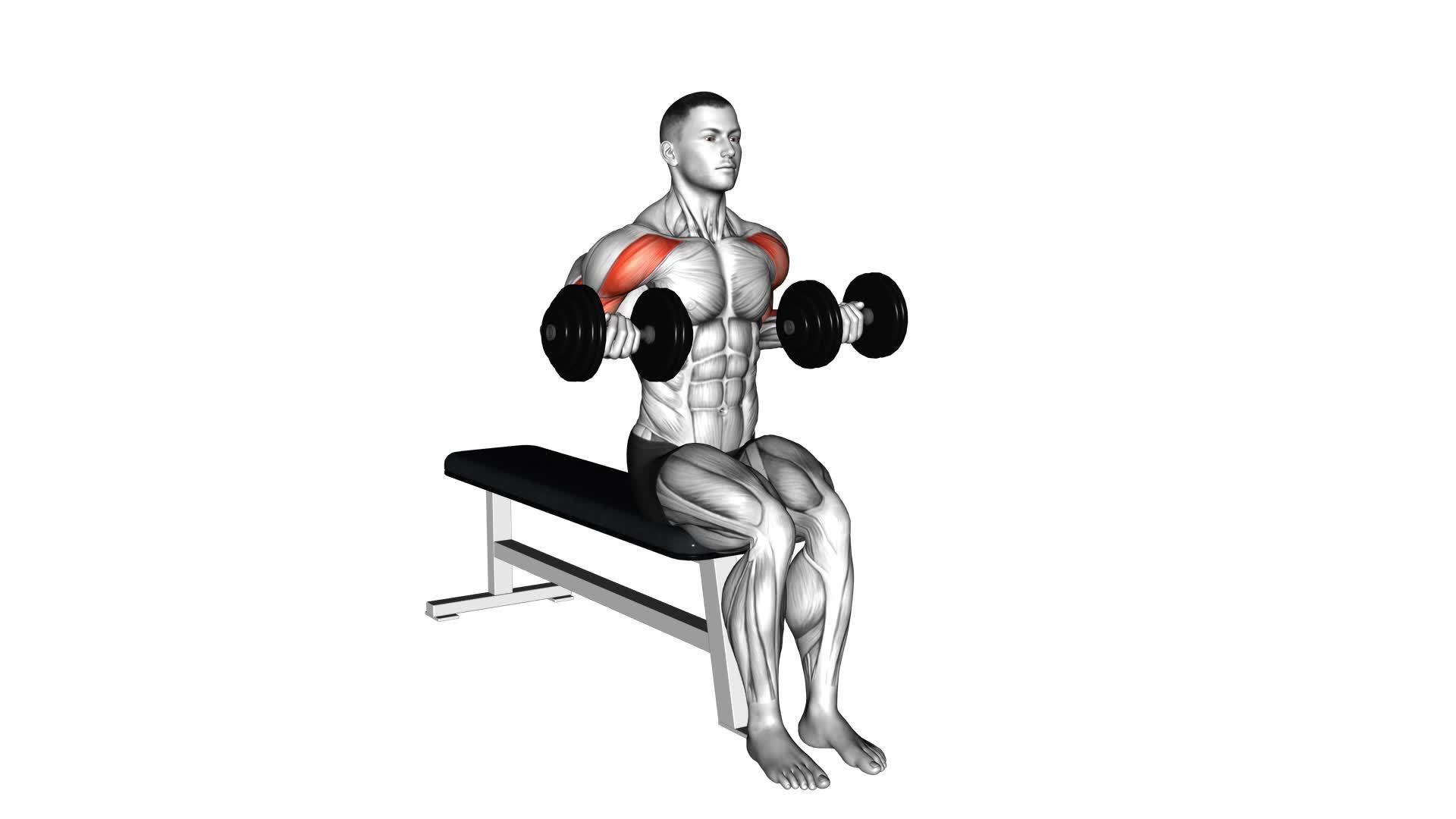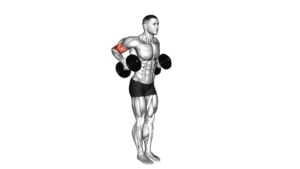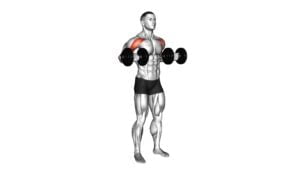Dumbbell Seated Drag Curl – Video Exercise Guide & Tips

Looking to improve your bicep strength and definition? Check out the Dumbbell Seated Drag Curl, a highly effective exercise that targets the biceps like never before.
Watch This Exercise Video
In this article, we'll guide you through proper form, common mistakes to avoid, and tips to enhance your performance.
Plus, we'll provide variations and progressions to keep challenging your muscles.
Get ready to take your bicep training to the next level with our video exercise guide and expert tips.
Key Takeaways
- Increased muscle activation and improved bicep development
- Reduced strain on the lower back compared to other bicep exercises
- Engages multiple muscle groups simultaneously
- Improves grip strength
Benefits of the Dumbbell Seated Drag Curl
You will often experience increased muscle activation and improved bicep development when performing the Dumbbell Seated Drag Curl. One of the advantages of this exercise is that it specifically targets the biceps, helping you achieve better results in terms of muscle growth and strength.
The seated position allows for better stability and isolation of the bicep muscles, ensuring that they're the primary focus during the movement. By dragging the dumbbells up along your torso, you engage the biceps more effectively, leading to increased muscle activation.
This exercise also puts less strain on your lower back compared to other bicep exercises, reducing the risk of injury and allowing you to focus solely on the biceps.
The Dumbbell Seated Drag Curl is a great addition to your workout routine if you want to specifically target and develop your biceps. Incorporating this exercise into your training regimen can help you achieve better results in terms of muscle growth and strength in your biceps.
Proper Form and Technique for the Dumbbell Seated Drag Curl
To perform the Dumbbell Seated Drag Curl with proper form and technique, follow these steps:
- Sit on a bench with your feet flat on the floor and your back straight.
- Hold a dumbbell in each hand, palms facing down, and let your arms hang straight down by your sides.
- Keep your elbows close to your body throughout the exercise.
- Slowly curl the dumbbells up towards your shoulders while keeping your palms facing down.
- As you curl the dumbbells, focus on squeezing your biceps and keeping your shoulders back.
- Once the dumbbells reach shoulder level, pause for a moment and squeeze your biceps.
- Slowly lower the dumbbells back down to the starting position, maintaining control and avoiding any swinging or jerking motions.
- Repeat for the desired number of repetitions.
Proper form and technique are essential for maximizing the benefits of the Dumbbell Seated Drag Curl. This exercise primarily targets the biceps, helping to increase arm strength and size. Additionally, it also engages the forearms and shoulders as stabilizer muscles.
The Dumbbell Seated Drag Curl can be modified by using different weights, grips, or performing the exercise on an incline or decline bench. These variations can target different areas of the biceps and provide additional challenges to your workout routine.
Remember to start with lighter weights and gradually increase as you become more comfortable with the exercise. Always consult with a fitness professional if you have any concerns or questions about performing this exercise correctly.
Common Mistakes to Avoid During the Dumbbell Seated Drag Curl
During the Dumbbell Seated Drag Curl, it's important to be mindful of common mistakes that can hinder your progress and potentially lead to injury. By avoiding these mistakes and focusing on proper form and technique, you can maximize the benefits of this exercise.
One common mistake to avoid is using momentum to lift the dumbbells. This not only reduces the effectiveness of the exercise, but it also puts unnecessary strain on your muscles and joints. Instead, focus on using controlled movements and engaging your biceps throughout the entire range of motion.
Another mistake to avoid is lifting too heavy of a weight. It's important to choose a weight that allows you to maintain proper form and complete the exercise with control. Lifting a weight that's too heavy can lead to poor form and increase the risk of injury.
Lastly, avoid shrugging your shoulders during the exercise. This can take the focus away from your biceps and shift it to your traps. Keep your shoulders relaxed and down throughout the movement.
By being mindful of these common mistakes, you can improve your performance in the Dumbbell Seated Drag Curl and reduce the risk of injury.
Transition sentence: Now that you're aware of the common mistakes to avoid, let's move on to some tips to enhance your performance in the dumbbell seated drag curl.
Tips to Enhance Your Performance in the Dumbbell Seated Drag Curl
Now that you're aware of the common mistakes to avoid, let's focus on enhancing your performance in the Dumbbell Seated Drag Curl. To get the most out of this exercise, it's important to pay attention to your grip positioning and breathing techniques. Here are some tips to help you improve your form and maximize your results:
- Grip Positioning:
- Start by holding the dumbbells with an underhand grip, palms facing upwards.
- Keep your hands shoulder-width apart to ensure stability and control during the exercise.
- Maintain a tight grip on the dumbbells throughout the movement to engage your forearm muscles effectively.
- Breathing Techniques:
- Before starting the curl, take a deep breath in to brace your core and stabilize your upper body.
- Exhale slowly as you lift the dumbbells towards your shoulders, maintaining a controlled and steady movement.
- Inhale as you slowly lower the dumbbells back down to the starting position.
By focusing on your grip positioning and breathing techniques, you can enhance your performance in the Dumbbell Seated Drag Curl. Remember to start with lighter weights and gradually increase the resistance as you become more comfortable with the exercise.
With consistency and proper form, you'll see improvements in your bicep strength and development.
Variations and Progressions for the Dumbbell Seated Drag Curl
Now let's move on to exploring variations and progressions for the Dumbbell Seated Drag Curl, building upon the tips and techniques we discussed earlier.
If you're looking to take your workout to the next level, there are a few advanced techniques you can incorporate into your dumbbell seated drag curl routine. One option is to increase the weight you're lifting. Gradually increasing the weight will challenge your muscles and help you build strength. Another advanced technique is to perform drop sets. This involves starting with a heavier weight and then immediately switching to a lighter weight once you reach muscle failure. This will help you push your muscles to their limit and stimulate further growth.
To incorporate the dumbbell seated drag curl into a full body workout routine, you can combine it with other exercises that target different muscle groups. For example, you can pair it with exercises like squats, lunges, or deadlifts to work your lower body. Alternatively, you can pair it with exercises like overhead presses or lateral raises to target your shoulders. By incorporating the dumbbell seated drag curl into a full body routine, you can maximize your workout and ensure that you're targeting all major muscle groups.
Remember to always listen to your body, and if any exercise causes pain or discomfort, consult with a fitness professional.
Frequently Asked Questions
How Many Sets and Reps Should I Do for the Dumbbell Seated Drag Curl?
For the dumbbell seated drag curl, it's important to gradually increase the weight and reps as you progress. Start with a weight that challenges you but allows you to maintain proper form. Aim for 3-4 sets of 8-12 reps.
As you get stronger, gradually increase the weight and aim for higher reps within that range. If you're looking for alternatives, you can try standing barbell curls or incline dumbbell curls for bicep development.
Can I Perform the Dumbbell Seated Drag Curl Without a Bench?
Yes, you can perform the dumbbell seated drag curl without a bench. If you don't have access to a bench, you can use a stability ball or an exercise ball instead.
Simply sit on the stability ball or exercise ball with your feet firmly planted on the ground and perform the drag curl using dumbbells.
Remember to maintain proper form and avoid common mistakes such as using momentum or swinging your body.
Is It Necessary to Warm up Before Doing the Dumbbell Seated Drag Curl?
Before performing the dumbbell seated drag curl, it's important to warm up your muscles to prevent injury and optimize performance. Warming up increases blood flow, improves flexibility, and prepares your body for the exercise.
Proper form and technique are crucial for the dumbbell seated drag curl. To perform it correctly, sit upright with your back supported, hold the dumbbells with an underhand grip, and curl them towards your chest while keeping your elbows back.
Can I Use Other Types of Weights, Such as Kettlebells, Instead of Dumbbells for This Exercise?
Yes, you can use other types of weights, such as kettlebells, instead of dumbbells for the dumbbell seated drag curl exercise.
However, it's important to note that the dumbbell seated drag curl offers unique benefits that may not be fully replicated with kettlebells.
The dumbbell variation specifically targets the biceps and forearms, helping to build strength and definition in those areas.
Additionally, the seated position helps to isolate the biceps and minimize cheating or swinging movements.
Will the Dumbbell Seated Drag Curl Help Me Build Biceps Size and Strength?
The dumbbell seated drag curl is a great exercise for building biceps size and strength. It targets the biceps brachii muscle group and helps to increase muscle definition. By performing this exercise correctly, you'll be able to effectively stimulate your biceps and promote muscle growth.
It's important to maintain proper form and avoid common mistakes such as using momentum or swinging the weights. Variations and technique for the dumbbell seated drag curl can further enhance its benefits.
Conclusion
In conclusion, the dumbbell seated drag curl is a beneficial exercise that targets the biceps and helps improve overall arm strength.
By maintaining proper form and avoiding common mistakes, you can maximize the effectiveness of this exercise.
To enhance your performance, consider incorporating variations and progressions into your routine.
Remember to always listen to your body and consult with a professional trainer if needed.

Author
Years ago, the spark of my life’s passion ignited in my mind the moment I stepped into the local gym for the first time. The inaugural bead of perspiration, the initial endeavor, the very first surge of endorphins, and a sense of pride that washed over me post-workout marked the beginning of my deep-seated interest in strength sports, fitness, and sports nutrition. This very curiosity blossomed rapidly into a profound fascination, propelling me to earn a Master’s degree in Physical Education from the Academy of Physical Education in Krakow, followed by a Sports Manager diploma from the Jagiellonian University. My journey of growth led me to gain more specialized qualifications, such as being a certified personal trainer with a focus on sports dietetics, a lifeguard, and an instructor for wellness and corrective gymnastics. Theoretical knowledge paired seamlessly with practical experience, reinforcing my belief that the transformation of individuals under my guidance was also a reflection of my personal growth. This belief holds true even today. Each day, I strive to push the boundaries and explore new realms. These realms gently elevate me to greater heights. The unique combination of passion for my field and the continuous quest for growth fuels my drive to break new ground.







